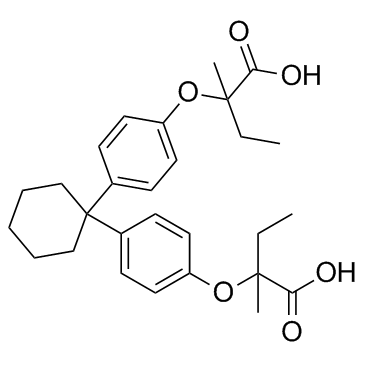30299-08-2
| 中文名 | 克利贝特 |
|---|---|
| 英文名 | Clinofibrate |
| 英文别名 |
UNII:0374EZJ8CU
2-[4-[1-[4-(2-carboxybutan-2-yloxy)phenyl]cyclohexyl]phenoxy]-2-methylbutanoic acid 2,2'-[1,1-Cyclohexanediylbis(4,1-phenyleneoxy)]bis(2-methylbutanoic acid) 2,2'-[cyclohexane-1,1-diylbis(benzene-4,1-diyloxy)]bis(2-methylbutanoic acid) Butanoic acid, 2,2'-[cyclohexylidenebis(4,1-phenyleneoxy)]bis[2-methyl- 2,2'-[Cyclohexane-1,1-diylbis(4,1-phenyleneoxy)]bis(2-methylbutanoic acid) MFCD00865769 |
| 描述 | Clinofibrate (S-8527)是一种降血脂药和一种HMG-CoA还原酶抑制剂。 |
|---|---|
| 相关类别 | |
| 体内研究 | Clinofibrate给药(50和100 mg/kg /天,po)显着抑制血浆纤维蛋白原水平以及血清和VLDL-LDL-脂质的增加[1]。 Clinofibrate显着降低动脉粥样硬化大鼠的高血浆胆固醇水平,为823±256 mg/dl,或约为对照大鼠的10倍(85±11 mg/dl)。在使用clinofibrate治疗时,极低密度脂蛋白(VLDL)部分的胆固醇水平降低最多[2]。在禁食2天后再喂食无脂肪饮食或5%脂肪饮食的大鼠。 30 mg/kg的丙环酸酯可降低血清和肝脏甘油三酯水平[3]。将S-8527口服摄入正常大鼠7天后,血清甘油三酯和胆固醇分别在1mg/kg和2mg/kg时降低约27%。 3mg/kg的S-8527使肝脏甘油三酯浓度降低约20%[4]。 |
| 动物实验 | 大鼠:使用体重100-160g的雄性Wistar大鼠。将S-8527和氯贝特悬浮在适量的阿拉伯树胶溶液中,使得每日剂量为每100g体重0.5mL。每天早上通过胃管将药物给予大鼠7天。对照组的车辆数量相等。在实验期间,动物随意喂食商业食物颗粒。在最后一次给药后约24小时,用乙醚麻醉大鼠,从下腔静脉获得血液样品。处死后,取出肝脏,用生理盐水洗涤,印在滤纸上并称重[4]。 |
| 参考文献 |
| 密度 | 1.2±0.1 g/cm3 |
|---|---|
| 沸点 | 613.8±55.0 °C at 760 mmHg |
| 熔点 | 143-145°C |
| 分子式 | C28H36O6 |
| 分子量 | 468.582 |
| 闪点 | 198.1±25.0 °C |
| 精确质量 | 468.251190 |
| PSA | 93.06000 |
| LogP | 6.71 |
| 蒸汽压 | 0.0±1.9 mmHg at 25°C |
| 折射率 | 1.559 |
| 储存条件 | Refrigerator |
|
Material Safety Data Sheet
Section1. Identification of the substance Product Name: Clinofibrate 2-(4-{1-[4-(1-carboxy-1-methylpropoxy)phenyl]cyclohexyl}phenoxy)-2-methylbutanoic acid Synonyms: Section2. Hazards identification Harmful by inhalation, in contact with skin, and if swallowed.
Section3. Composition/information on ingredients. Ingredient name:Clinofibrate CAS number:30299-08-2 Section4. First aid measures Skin contact:Immediately wash skin with copious amounts of water for at least 15 minutes while removing contaminated clothing and shoes. If irritation persists, seek medical attention. Eye contact:Immediately wash skin with copious amounts of water for at least 15 minutes. Assure adequate flushing of the eyes by separating the eyelids with fingers. If irritation persists, seek medical attention. Inhalation:Remove to fresh air. In severe cases or if symptoms persist, seek medical attention. Ingestion:Wash out mouth with copious amounts of water for at least 15 minutes. Seek medical attention. Section5. Fire fighting measures In the event of a fire involving this material, alone or in combination with other materials, use dry powder or carbon dioxide extinguishers. Protective clothing and self-contained breathing apparatus should be worn. Section6. Accidental release measures Personal precautions: Wear suitable personal protective equipment which performs satisfactorily and meets local/state/national standards. Respiratory precaution:Wear approved mask/respirator Hand precaution:Wear suitable gloves/gauntlets Skin protection:Wear suitable protective clothing Eye protection:Wear suitable eye protection Methods for cleaning up: Mix with sand or similar inert absorbent material, sweep up and keep in a tightly closed container for disposal. See section 12. Environmental precautions: Do not allow material to enter drains or water courses. Section7. Handling and storage Handling:This product should be handled only by, or under the close supervision of, those properly qualified in the handling and use of potentially hazardous chemicals, who should take into account the fire, health and chemical hazard data given on this sheet. Store in closed vessels, refrigerated. Storage: Section8. Exposure Controls / Personal protection Engineering Controls: Use only in a chemical fume hood. Personal protective equipment: Wear laboratory clothing, chemical-resistant gloves and safety goggles. General hydiene measures: Wash thoroughly after handling. Wash contaminated clothing before reuse. Section9. Physical and chemical properties Appearance:Not specified Boiling point:No data No data Melting point: Flash point:No data Density:No data Molecular formula:C28H36O6 Molecular weight:468.6 Section10. Stability and reactivity Conditions to avoid: Heat, flames and sparks. Materials to avoid: Oxidizing agents. Possible hazardous combustion products: Carbon monoxide. Section11. Toxicological information No data. Section12. Ecological information No data. Section13. Disposal consideration Arrange disposal as special waste, by licensed disposal company, in consultation with local waste disposal authority, in accordance with national and regional regulations. Section14. Transportation information Non-harzardous for air and ground transportation. Section15. Regulatory information No chemicals in this material are subject to the reporting requirements of SARA Title III, Section 302, or have known CAS numbers that exceed the threshold reporting levels established by SARA Title III, Section 313. SECTION 16 - ADDITIONAL INFORMATION N/A |
CHEMICAL IDENTIFICATION
HEALTH HAZARD DATAACUTE TOXICITY DATA
|


